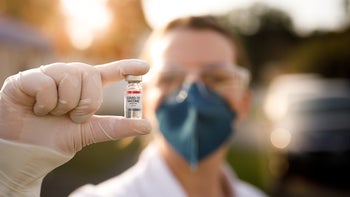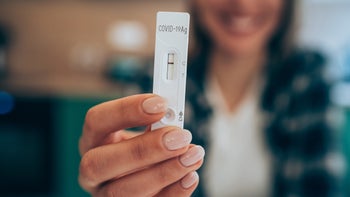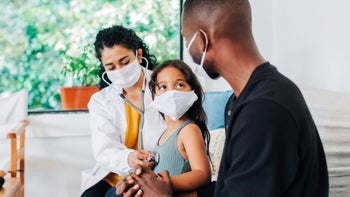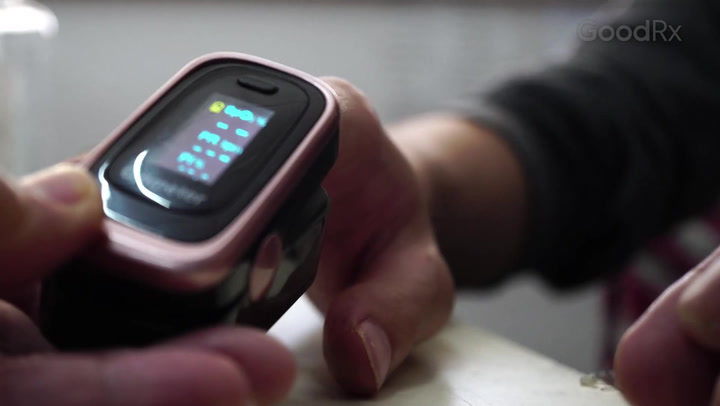
Is Sore Throat a Symptom of COVID-19? Yes, These 9 Remedies Can Help You Feel Better Fast
Key takeaways:
Sore throat is one of the most common symptoms of COVID-19.
Remedies for COVID sore throat include over-the-counter pain relievers, warm or cold fluids, and throat rest.
Some people may also benefit from prescription medications that fight the COVID-19 virus.
Access savings on related medications

If you’ve recently been diagnosed with COVID-19, a sore throat might have been your first clue that something wasn’t right. Studies show that sore throat is now a common symptom of COVID illness. In one survey, more than half of people in the U.K. reported having a sore throat when they had COVID-19.
COVID sore throat can be very painful. If you’re looking for ways to treat your COVID sore throat, here are nine science-backed ways to feel better faster.
What are the symptoms of COVID sore throat?
Pain is the biggest symptom of COVID sore throat. But it varies from person to person. Some people describe COVID sore throat as the most painful sore throat they’ve ever experienced. Others report having a sore throat that’s similar to one caused by a regular cold.
SHINGRIX (Zoster Vaccine Recombinant, Adjuvanted) is now $0 for almost everyone*
Get SHINGRIX at the pharmacy or in-network doctor’s office today. 98% of privately insured people pay $0 and all Medicare Part D beneficiaries pay $0 at the pharmacy.
Prescribing Information
*Coverage and cost may vary and are subject to change without notice. Reimbursement decisions are made by individual insurance plans.


SHINGRIX is an FDA-approved vaccine for the prevention of shingles (herpes zoster) in adults 50 years and older. SHINGRIX is not used to prevent chickenpox.
• You should not receive SHINGRIX if you are allergic to any of its ingredients or had an allergic reaction to a previous dose of SHINGRIX
• An increased risk of Guillain-Barré syndrome (severe muscle weakness) was observed after vaccination with SHINGRIX
• Fainting can happen after getting injectable vaccines, including SHINGRIX. Precautions should be taken to avoid falling and injury due to fainting
• The most common side effects are pain, redness, and swelling at the injection site, muscle pain, tiredness, headache, shivering, fever, and upset stomach
• SHINGRIX was not studied in pregnant or nursing women. Tell your healthcare provider if you are pregnant, plan to become pregnant, or are breastfeeding
• Vaccination with SHINGRIX may not protect all individuals
• Ask your healthcare provider about the risks and benefits of SHINGRIX. Only a healthcare provider can decide if SHINGRIX is right for you
You are encouraged to report vaccine adverse events to the US Department of Health and Human Services. Visit www.vaers.hhs.gov to file a report, or call 1-800-822-7967.
For US audiences.
Trademarks are property of their respective owners.
©️2024 GSK or licensor.
PMUS-SGXWCNT240015 May 2024
Produced in the USA.
GoodRx Health information and resources are reviewed by our editorial staff with medical and healthcare policy and pricing experience. See our editorial policy for more detail. We also provide access to services offered by GoodRx and our partners when we think these services might be useful to our visitors. We may receive compensation when a user decides to leverage these services, but making them available does not influence the medical content our editorial staff provides.
Other COVID sore throat symptoms that people notice include:
Pain when swallowing or talking
Itching in the throat
Redness in the back of the throat
People may also experience other common symptoms of COVID-19, like:
Fever
Fatigue
Cough
Runny nose
Headache
What are the best COVID sore throat remedies?
There’s no cure for COVID-19. And, since the illness is caused by a virus, antibiotics won’t help your sore throat feel better.
But there are plenty of treatments you can try at home to get quick relief from your COVID sore throat.
There aren’t studies comparing these treatments, so it’s impossible to say which option is the best. The right COVID sore throat remedy for you could be a combination of two or more of these options.
What does COVID-19 sore throat feel like? Four people share their experiences with this condition.
Did you know COVID can cause dizzy spells? Here’s what researchers know about how COVID triggers dizziness, how common it is, and what you can do about it.
Does COVID cause hair loss? Not directly. But COVID can trigger stress-related hair loss.
1. Cold liquids
Cold liquids or foods are like an ice pack for the throat. And they’re some of the best foods to help relieve a sore throat. Sipping on cold liquids throughout the day can help relieve your sore throat symptoms. You can also try ice chips, popsicles, and ice cream.
2. Warm fluids
Heat can also help soothe inflammation. Some people swear by heat versus cold for pain relief. But there's no evidence that one is actually better than the other, especially for relieving sore throats. So, if you don’t get relief with cold liquids, try warm ones instead.
And, even if cold liquids do help, don’t be afraid to switch it up and also include warm fluids for their soothing effects. Just make sure the liquids aren’t too hot, so you don’t burn your throat and worsen the pain. Good options include warm tea, broth, and soups.
3. Over-the-counter pain relievers
Over-the-counter (OTC) pain medications, like acetaminophen (Tylenol) and ibuprofen (Motrin), can relieve your COVID sore throat pain for a few hours at a time.
Some studies show that ibuprofen works better for sore throat pain relief than acetaminophen. While these studies didn’t specifically look at COVID sore throat, it’s clear that either medication can help lessen sore throat pain.
If you have certain medical conditions, one of these medications may be safer for you than others. A healthcare professional can give you advice on which pain reliever you should choose.
4. Throat lozenges and sprays
OTC throat lozenges and sprays can also provide pain relief. Sprays can be harder to use, so most people opt for lozenges. But, for young children and older people with swallowing difficulties, lozenges are a choking hazard, so a spray is the way to go.
These products relieve COVID sore throat by temporarily numbing the area. Look for lozenges and spray with these active ingredients:
Menthol
Dyclonine
Benzocaine
Some lozenges contain both menthol and benzocaine, which may offer additional relief.
You can also try honey, which can coat the back of your throat and provide pain relief. There’s no data to show that honey specifically helps relieve COVID sore throat. But research shows that honey can relieve throat pain in adults who have other types of sore throat. Honey is a safe option to try for anyone over 12-months old.
5. Saltwater gargles
This common home remedy can help relieve sore throat and pain from mouth inflammation. One study showed that saltwater gargles relieved sore throat pain just as well as a prescription-strength numbing agent.
Here’s how to do a saltwater gargle:
Mix ½ tsp of salt in 8 oz of warm water. Stir until all the salt is dissolved.
Take a sip, tilt your head back, and gargle for about 10 seconds.
Spit the salt water out into a sink.
Repeat this process until your pain feels better.
You can do a saltwater gargle every 3 hours.
6. Moist air
Breathing in moist air may help soothe your sore throat. You can breathe in the steam from a shower or even a hot bowl of water. You can also run a humidifier, which may also help other COVID-19 symptoms, like congestion.
7. Complementary and alternative medicine
There aren’t studies looking at complementary and alternative medicine (CAM) treatments for COVID sore throat. But some studies have looked at CAM and sore throat from other causes. There’s some evidence that acupuncture can temporarily relieve sore throat. There’s also evidence that traditional Chinese herbs can relieve throat pain.
8. COVID-19 antivirals
If you’re at high risk for severe COVID-19 illness, you may be eligible for antiviral treatment. Antivirals can help keep you from getting severely sick and may also relieve your symptoms. If you’re at risk for developing severe COVID-19 illness, talk to a healthcare professional about antiviral treatment.
Paxlovid is the most commonly prescribed COVID-19 antiviral. For it to help, you need to start it by the fifth day of your symptoms. Paxlovid and other COVID-19 antivirals are only available by prescription.
9. Throat rest
Giving your throat a break, known as throat rest, isn’t exactly a treatment. But it can keep you from accidentally making your COVID sore throat worse.
Until you recover, avoid things that can irritate your throat, such as:
Crunchy foods (like chips), which can have sharp edges that might scratch the throat
Spicy and acidic foods (including coffee), which can further irritate the throat
Smoke, which dries out the throat and makes throat pain worse
It’s also a good idea to avoid shouting and yelling. This can strain your throat muscles and vocal cords and worsen your sore throat.
How do you know if your sore throat is caused by COVID-19 or something else?
You can’t tell if your sore throat is from COVID-19 or something else based on your symptoms alone. You’ll need to get a COVID test to know for sure whether your symptoms are from COVID or another infection.
Here some things to keep in mind:
Flu and RSV don’t typically cause sore throat. But these conditions can cause congestion and postnasal drip, which can trigger throat irritation.
Strep throat is a bacterial infection that also causes throat pain and fever. Strep throat doesn’t usually cause congestion or runny nose. It’s more common in kids, but adults can get strep throat, too.
How long does a COVID-19 sore throat last?
Most symptoms of COVID-19 last anywhere from several days to 2 weeks. But this can vary from person to person.
COVID sore throat usually starts feeling better after a week, though it may take a little longer to completely go away. If your sore throat isn’t getting better within a week, or if it’s getting worse, check in with a healthcare professional.
The bottom line
Having a sore throat is a common symptom of many viral illnesses, including COVID-19. COVID sore throat can be very painful. But there are several home remedies that can help. Great options include warm fluids, cold liquids, over-the-counter pain relievers (Tylenol, Motrin), and lozenges with menthol.
Although there’s no single “best” option, you can use several remedies together to get the best results. If you’re at risk for developing serious COVID-19 illness, antiviral treatment, like Paxlovid, can help keep you healthy and relieve your sore throat.
Why trust our experts?


References
Administration for Strategic Preparedness & Response. (n.d.). COVID-19 treatment information for patients.
Centers for Disease Control and Prevention. (2024). Sore throat basics.
Chrubasik, S., et al. (2012). Efficacy of a benzocaine lozenge in the treatment of uncomplicated sore throat. European Archives of Oto-rhino-laryngology.
French, S. D., et al. (2006). A Cochrane review of superficial heat or cold for low back pain. Spine.
Geißler, K., et al. (2020). The effect of adjuvant oral application of honey in the management of postoperative pain after tonsillectomy in adults: A pilot study. PLoS One.
Huang, Y., et al. (2012). Chinese medicinal herbs for sore throat. Cochrane Database of Systematic Reviews.
Moss, D. A., et al. (2015). Ear acupuncture for acute sore throat: A randomized controlled trial. Journal of the American Board of Family Medicine.
Passàli, D., et al. (2001). Efficacy and safety of ketoprofen lysine salt mouthwash versus benzydamine hydrochloride mouthwash in acute pharyngeal inflammation: A randomized, single-blind study. Clinical Therapeutics.
Schachtel, B. P., et al. (1988). Sore throat pain in the evaluation of mild analgesics. Clinical Pharmacology and Therapeutics.
Watt, E. E., et al. (2008). Menthol shares general anesthetic activity and sites of action on the GABA(A) receptor with the intravenous agent, propofol. European Journal of Pharmacology.
Wise, J. (2022). COVID-19: Symptomatic infection with omicron variant is milder and shorter than with delta, study reports. BMJ.
ZOE Health Study. (2024). Latest daily U.K. COVID-19 data: Vaccines, cases, trends.
























